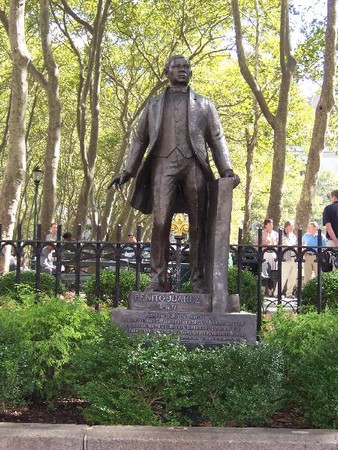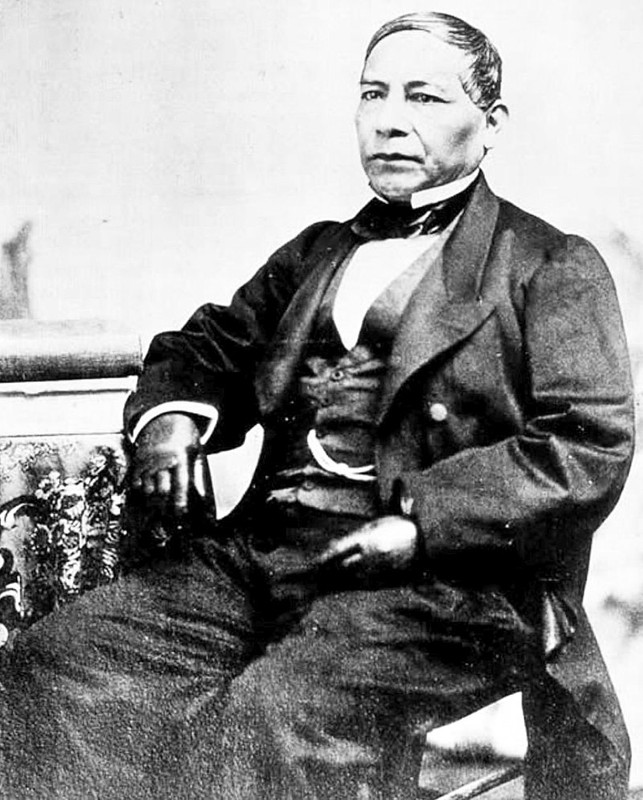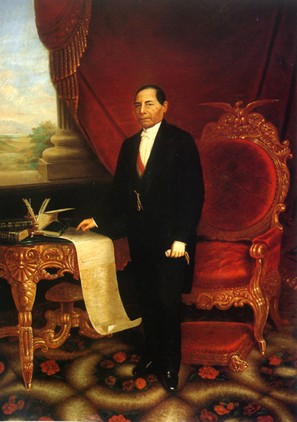Benito Juárez Monument
Introduction
Text-to-speech Audio
Images
Monument to Benito Juárez

Daguerreotype of Juárez as president

Juárez's presidential portrait

Backstory and Context
Text-to-speech Audio
When Benito Juárez was born at the beginning of the nineteenth century, Mexico was still ruled by Spain and it was a feudalistic society that favored those born in Europe over those born in the Americas. Mexico’s Native populations made up the lowest classes of society. Benito Juárez was born in 1808 in Oaxaca, part of the Zapotec nation. His parents died when he was three and he was cared for by his paternal grandparents until they also died. Afterwards he stayed with an uncle and worked as a farmhand until the age of twelve. His uncle taught him the basics of reading, but only Zapotec was spoken in their community and Juárez realized that to advance in society he needed to learn Spanish. For the poor who could not afford an education, it was typical that children would enter domestic service in exchange for schooling. At age twelve Juárez ran away from his uncle’s home and traveled to the city of Oaxaca to find his sister who was already a domestic servant. The family she was employed with took to Juárez and helped him find a placement where he could get some access to education.
Most schooling was overseen by the Catholic Church and Native Indians received inequal schooling compared to their Spanish peers. Looking for better opportunity his benefactor helped Juárez enrolled at the Holy Cross Seminary at age fifteen, where he was one of very few Indian students. Wanting the education, but not to take a position in the Church, he finished his course of study at the Seminary and the transferred to the new liberal Institution of Arts and Science in 1828. There he studied law and the sciences and quickly entered law and politics. In 1831, at age 25, he ran for public office and was elected municipal alderman, in 1833 he was elected to the Oaxaca state legislature, and in 1834 he passed the bar.
As Juárez entered law and public service, Mexico was experiencing increased conflict between liberal and conservative factions as well as the dictatorial leadership of Antonio Lopéz de Santa Anna. For many years, the power struggle shifted power back and forth between the factions with great instability. Around 1834 Santa Anna tightened his power, stopped all reform legislation, and kicked all liberal politicians from their positions (including Juárez). Juárez was part of the liberal faction, pushed for reform, and was a lawyer known for defending poor clients. In his early years as a lawyer he witnessed examples of corruption and abuse of the poor which started him on the path towards being a reformer.
While Juárez was a liberal he was able to advance his professional career because he accepted conservative appointments. He was appointed as a judge in 1841 and then was secretary in 1844 to the conservative governor of Oaxaca. When he resigned his position over an order that did match his principles it did not ruin his chances because he was quickly made a state prosecutor and then was seated on the state Supreme Court. In 1845 he was elected to the state legislature a second time. With the Texas War for Independence in the 1830s and the Mexican-American War in the 1840s, Santa Anna was in and out of power and Mexico frequently switched between the liberal and conservative factions. In 1846, just before the outbreak of war with the United States, a liberal government ruled Mexico and Santa Anna was in exile. With the liberal faction in power, Juárez was chosen as one of three men to lead Oaxaca provisionally and then he was elected as a deputy to a special congress meant to revise the constitution. When the Mexican-American War began, this congress turned into a war congress and Santa Anna made his way back into power again. To fund the war Santa Anna targeted the Church to raised funds and in Oaxaca this meant a resolution to mortgage church property to raise money. This led to a clergy-incited rebellion of a military regiment in an incident called the Revolt of the Polkos. Santa Anna repealed the resolution to the cheers of the conservative clergy, even though it had been passed on his orders, and again the liberals were ousted from the capital.
Juárez returned home to Oaxaco in 1847 and resumed his law practice but was soon named Governor of the state by the legislature to serve provisionally starting October 29, 1847. He was officially elected to a new term in August 1848. During his time as governor, Juárez was seen as an honest and hardworking politician who upheld his oath, even working with the church because he needed its cooperation to effectively run the state. He also worked for his own Native people, trying to work towards their assimilation into Mexican society, increasing their access to education, and improving their living conditions. While his main goal was defense during the war, his key project was education—he built 200 schools, trained Native teachers, increased student enrollment, and encouraged girls to have access to education. He also worked towards internal improvements like building roads and other public projects, in which he could work with the church for the betterment of the community and increase employment. He was punctual and improved financial and bureaucratic integrity in the state, spent tax money wisely, and reduced the state debt. He also went out and personally did work among the people, unlike many political figures.
While Juárez worked as the Governor of Oaxaca, Mexico as a nation struggled to recover from the devastating Mexican-American War and avoid financial collapse. In a continuing period of instability, the nation went through a series of presidents before Santa Anna came back into power once again. Once Santa Anna had resumed leadership of the country he targeted Juárez for a perceived slight a few years earlier (Juárez was apparently unaware that he had slighted Santa Anna in this incident, but Santa Anna perceived it to have been a purposeful act against him). After Juárez’s term as governor ended in 1852 he had resumed his law practice and been made director of the Institute of Arts and Science. However, the new conservative governor soon had Juárez removed from the position and in 1853 Santa Anna took his revenge for the perceived slight. In May 1853, as Juárez was circuit riding to assist his legal clients among the poor, he was arrested by soldiers in Etla on May 27 and taken to Jalapa. As the capital of Veracruz, this was a Santa Anna stronghold, and Juárez was held under house arrest for 75 days. He was then taken to the barracks jail and sent on a ten day secret journey to the fortress of San Juan de Ulúa at Veracruz harbor. He was kept in solitary confinement in the dungeon for twelve days. On October 9, 1853 he was informed that he was exiled to Europe, handed a passport, and put on an English steamer with no money, belongings, or even arrangements for his passage.
Once his identity was known, passengers on the steamer helped Juárez pay for his passage to Havana and once there his friends and allies managed to track him down. He then made his way to New Orleans. Juárez did not know the reason for his deportation (the slight that Santa Anna thought he had experienced) and he attributed it to ugly politics. A group of fellow exiles began to gather in New Orleans and work for their mutual survival, meanwhile Juárez also studied American law and politics and English. Meanwhile, Santa Anna’s rule in Mexico was becoming more and more oppressive and a revolution started against him in 1854, led by General Juan Alvarez. Santa Anna fled to Havana and the New Orleans exiles were able to return to Mexico to join the revolutionary movement. Alvarez was elected president by representatives of all the states while in route to the capital and he chose Juárez as his minister of justice and public instruction. The most influential measure Juárez passed in this position was the Juárez Law that eliminated judicial immunities of clergy and the military in civil courts and abolished the special courts for these classes. Alvarez was not president for long due to opposition (he was a general, not a politician) and he stepped down in favor of his top advisor, Ignacio Comonfort. Juárez also stepped down from his position to allow Comonfort to choose his cabinet and the new president asked him to return to Oaxaca as governor again.
Juárez served as Oaxaca’s governor until 1857; in that year Mexico adopted a new constitution and both Comonfort and Juárez were reelected to their respective positions. However, Comonfort asked Juárez to be his minister of the interior and Juárez traveled to the capital in November 1857. Almost immediately after the election, Comonfort decided not to rule under the new constitution and overthrew his own government to become a dictator under the Plan of Tacubaya led by General Félix Zuloaga. Juárez refused to go along with this plan and was arrested in December 1857, only a month after arriving in the capital. The tables quickly turned on Comonfort and Zuloaga forced him to step down and go into exile so that Zuloaga could now declare himself the new president. In response to this betrayal, before he departed the country, Comonfort secretly released Juárez who was his vice president and constitutional successor and allowed him to escape. Comonfort then publicly declared that if he were to resign his position he would do so in favor of Juárez. Juárez was now constitutional president under a constitution that had been overthrown by the military coup of Zuloaga.
Juárez gathered allies and troops together to oppose Zuloaga and made his capital in Veracruz. The conflict between Juárez’s constitutional government and the government of Zuloaga is known as the War of the Reform, or the Three Years’ War, from 1858 to 1861. At the end of the conflict, Juárez’s forces defeated Zuloaga and Juárez reentered Mexico City as president. While the war was over there was still a lot of violence and unrest and Mexico was in financial crisis. The Juárez government had to balance reform with the needs of recovery. Juárez also immediately set up new elections for president and congress to allow the nation to vote; he had been acting president after Comonfort was ousted but had not been elected to that position under the constitution. Juárez was one of the candidates for president and about a month before the election he surrendered much of his power to Congress in order to not influence the vote. Juárez was reelected as president, but not without opposition.
Juárez moved from one crisis to another. The financial crisis in Mexico was severe and in 1861 Congress voted (with Juárez’s approval) to suspend payments of all foreign debt. In response, France and Britain broke or suspended their diplomatic relations with Mexico, and France, Britain, and Spain signed an alliance of intervention. Britain simply wanted its debts paid, and Juárez’s administration was able to settle affairs with Britain and Spain. Napoleon III of France, however, saw an opportunity for something more and invaded Mexico. The French set up a puppet Mexican government at Orizaba and began setting the stage for Archduke Maximilian of Austria to be placed on the throne of Mexico. After fighting the internal War of the Reform for three years, Juárez now had to muster Mexico again to fight against the French invasion. The Mexican army defeated the French at Puebla on May 5, 1862 (commemorated as Cinco de Mayo), but the French captured Mexico City in May 1863 and sent Juárez again into running a moving, refugee government. The Mexican puppet government under the French proclaimed the empire for France and rigged popular support for the reign of Maximilian who then accepted the Mexican crown on April 10, 1864. Maximilian I and his wife, Charlotte or Carlota, made many blunders in Mexico, alienated the Catholic Church, and made a mandatory death penalty against anyone carrying arms against the empire.
Juárez continued to run the opposition government and resistance against the French and Maximilian. His presidential term was supposed to expire on December 1, 1865, but the nation could not hold elections and the next in line, President of the Supreme Court (and opponent to Juárez) González Ortega had fled to country and was in New York due to the war. Juárez extended his term until the end of the war and declared that Ortega had abandoned his position. There was strong pushback that he was trying to become a dictator, but most of his supporters remained with him in fighting against the French. With the end of the United States Civil War in 1865, the United States started to put pressure on France to leave and there was (unofficial) military and supply support along the US-Mexico border. With increasing international pressure and trouble back home in Europe, Napoleon started abandoning Maximilian and pulled the French army out of Mexico in 1866 and 1867. With France pulling out Maximilian realized his true position. He decided to abdicate the throne, but Carlota talked him out of it and went to Europe to plead for support. When both Napoleon and Pope Pius IX denied any help to Maximilian, she had a mental breakdown and required care in Austria. Meanwhile, Maximilian tried to abdicate again in Mexico, but his supporters convinced him to stay. He took to the field as commander-in-chief and joined the last stronghold of imperial forces at Querétaro. Juárez’s forces slowly retook Mexico and moved back towards Mexico City. On May 15, 1867, after weeks of siege, the imperial forces were forced to surrender and Maximilian was captured on the Hill of the Bells. Maximilian and two of his generals were court-martialed and sentenced to death and the three men were executed on June 19, 1867 on the Hill of the Bells.
Juárez returned to Mexico City again in the wake of war and facing recovery and financial crisis. He won reelection to the presidency in 1867 and again in 1871, despite increasing health issues. There still was a lot of political division in Mexico and Juárez faced one more uprising from former ally Porfirio Diaz after he was defeated in the election (which the nation soundly rejected). Juárez continued to govern through the death of his wife and his own ailing health. In the spring of 1872 he had two heart attacks and then on July 18, 1872 he was struck with angina pectoris (heart seizure). Between attacks he continued the business of government through the day and then sometime before midnight, when no one was watching, he died. In Mexican memory, Benito Juárez saved the nation from instability and staunchly protected the progression towards constitutional democracy in Mexico. While his rule was not without major opposition at times, in modern memory he is a national symbol of Mexican nationalism.
In 1945 Mayor Fiorello La Guardia renamed Sixth Avenue the Avenue of the Americas to celebrate New York’s rising status of a world capital and advocate for the headquarters of the United Nations to be built in the city. La Guardia also hoped to attract consulates to Sixth Avenue for nations of the Western Hemisphere and in renaming the Avenue of the Americas he sought to honor Pan-American ideals. This statue to Benito Juárez is one of seven statues on Sixth Avenue of Latin or South American leaders. Also at Bryant Park is José Bonifácio de Andrada e Silva of Brazil, at the southern end is Juan Pablo Duarte (1813-1876) of the Dominican Republic and General Jose Artigas (1764-1850) of Uruguay, and at Central Park are José Martí (1853-1895) of Cuba, General José de San Martín (1778-1850) of Argentina, and Simón Bolívar (1783-1830).
Cite This Entry
Thompson, Kathleen. "Benito Juárez Monument." Clio: Your Guide to History. December 7, 2020. Accessed March 29, 2025. https://theclio.com/entry/21864/tour/10/reverse
Sources
“Benito Juarez.” Bryant Park. Accessed December 7, 2020. https://www.nycgovparks.org/parks/bryant-park/monuments/1969.
Blancké, W. Wendell. Juárez of Mexico. New York: Praeger Publishers, 1971.
Weeks, Charles A. The Juárez Myth in Mexico. Tuscaloosa: The University of Alabama Press, 1987.
“Benito Juarez.” Bryant Park. Accessed December 7, 2020. https://www.nycgovparks.org/parks/bryant-park/monuments/1969.
"Benito Juárez." Wikipedia. Accessed December 7, 2020. https://en.wikipedia.org/wiki/Benito_Ju%C3%A1rez.
"Benito Juárez." Wikipedia. Accessed December 7, 2020. https://en.wikipedia.org/wiki/Benito_Ju%C3%A1rez.

